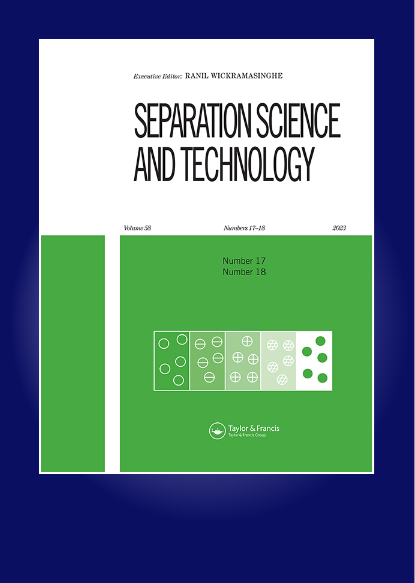Adsorption of methylene blue from aqueous solution on biochar prepared from a K-rich biomass Alternanthera philoxeroides
IF 2.3
4区 工程技术
Q3 CHEMISTRY, MULTIDISCIPLINARY
引用次数: 0
Abstract
ABSTRACT Alternanthera philoxeroides (AP) is a typical invasive plant. The quick spread of AP biomass may cause serious threat to ecological balance and biodiversity of the local area. However, AP has a high content of potassium, making it possible for preparing biochar through a self-activation process. In this study, AP biomass was employed to prepare porous carbon through a simple one-step pyrolysis. The effect of pyrolysis temperature (T) and carrier gas flow rate (v) onto the target carbon was intensively discussed. The obtained carbon were employed as adsorbents for methylene blue (MB) adsorption. Results showed that both of the T and v played great influence on the porous structure of the obtained biochar. Higher pyrolysis temperature and lower carrier gas flow rate were in favor of the formation of micropore and mesopore. The biochar obtained from 900°C pyrolysis temperature and 20 cm3 min−1 carrier gas flow rate (BC/900–20) possessed a satisfying specific surface area (825.6 m2 g−1) through the direct one-step pyrolysis, verifying the existence of pyrolysis gas self-activation and inorganic salt template self-activation effect. The maximum adsorption capacities calculated from Langmuir model were 424.9 mg g−1 for BC/900–20, which was comparable to that of the adsorbents reported recently.富钾生物炭对亚甲基蓝的吸附研究
摘要/ abstract摘要:黄菖蒲(ternanthera philoxeroides)是典型的入侵植物。AP生物量的迅速扩散可能对当地生态平衡和生物多样性造成严重威胁。然而,AP具有高钾含量,使其通过自激活过程制备生物炭成为可能。本研究以AP生物质为原料,通过简单的一步热解法制备多孔碳。重点讨论了热解温度(T)和载气流量(v)对目标碳的影响。所得碳作为吸附剂用于亚甲基蓝的吸附。结果表明,T和v对所得生物炭的多孔结构都有很大的影响。较高的热解温度和较低的载气流速有利于微孔和中孔的形成。在900℃热解温度和20 cm3 min - 1载气流速(BC/900 - 20)下,通过直接一步热解得到的生物炭具有令人满意的比表面积(825.6 m2 g - 1),验证了热解气体自活化和无机盐模板自活化效应的存在。Langmuir模型计算的BC/ 900-20的最大吸附量为424.9 mg g−1,与最近报道的吸附剂相当。关键词:莲子草热解自活化吸附亚甲基蓝新颖以富钾生物质莲子草为前驱体,采用简单的一步自活化热解法制备多孔炭材料。重点讨论了热解温度和热解过程中载气流速对所得碳材料性能的影响。在900℃热解温度和20 cm3 min-1载气流速条件下制备的生物炭对亚甲基蓝具有满意的比表面积和吸附能力。作者感谢四川大学分析测试中心在FTIR, XRD和SEM分析方面的帮助。披露声明作者未报告潜在的利益冲突。本研究得到国家自然科学基金资助[81927809]
本文章由计算机程序翻译,如有差异,请以英文原文为准。
求助全文
约1分钟内获得全文
求助全文
来源期刊

Separation Science and Technology
工程技术-工程:化工
CiteScore
6.10
自引率
3.60%
发文量
131
审稿时长
5.7 months
期刊介绍:
This international journal deals with fundamental and applied aspects of separation processes related to a number of fields. A wide range of topics are covered in the journal including adsorption, membranes, extraction, distillation, absorption, centrifugation, crystallization, precipitation, reactive separations, hybrid processes, continuous separations, carbon capture, flocculation and magnetic separations. The journal focuses on state of the art preparative separations and theoretical contributions to the field of separation science. Applications include environmental, energy, water, and biotechnology. The journal does not publish analytical separation papers unless they contain new fundamental contributions to the field of separation science.
 求助内容:
求助内容: 应助结果提醒方式:
应助结果提醒方式:


